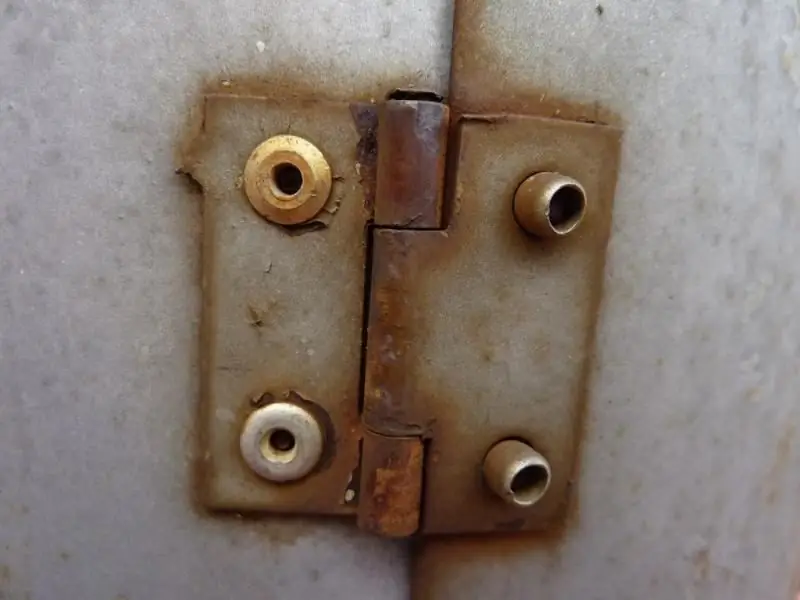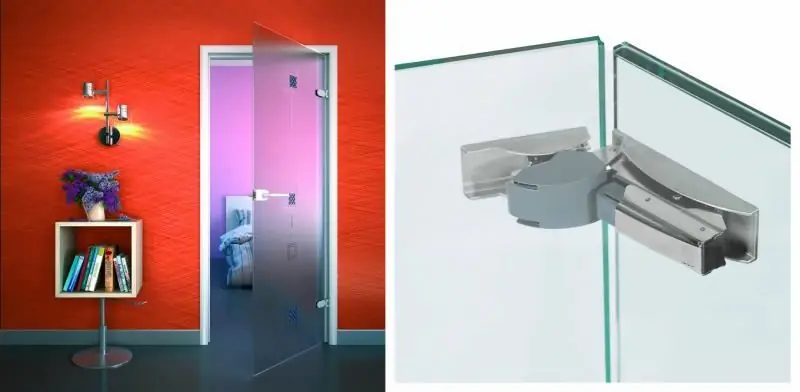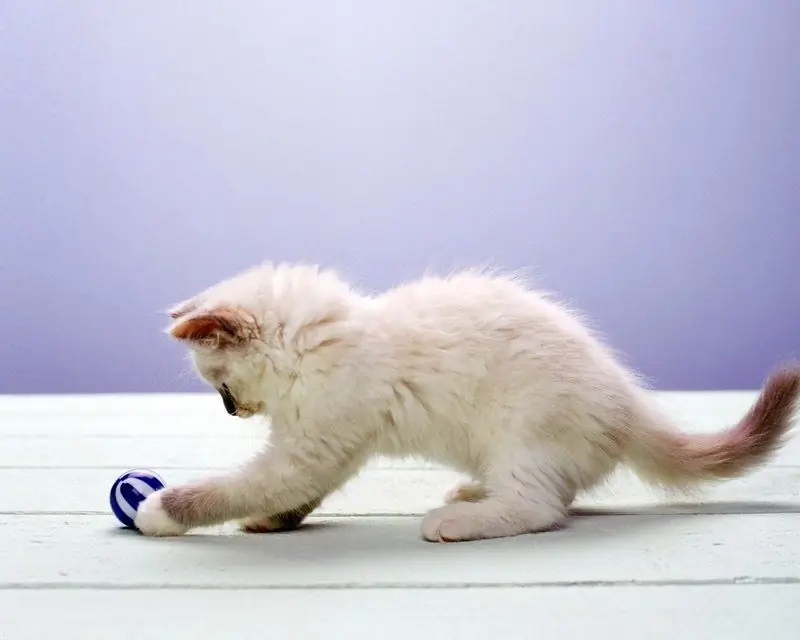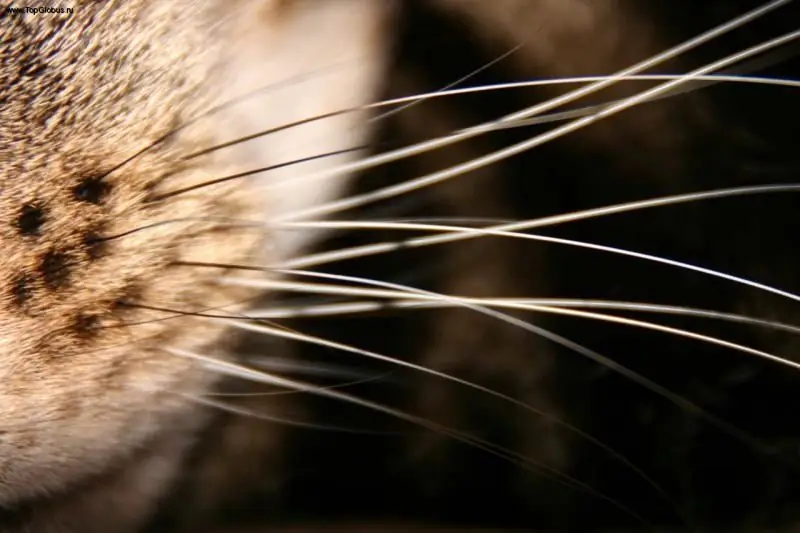
Table of contents:
- Author Bailey Albertson [email protected].
- Public 2023-12-17 12:53.
- Last modified 2025-01-23 12:41.
How and how to lubricate door hinges so that they do not creak

The constant creaks of door hinges annoy everyone living in the apartment. An unpleasant sound appears every time you open and close doors, or even during a slight draft. If the hinges are completely rusty, then this is not surprising. But with improper operation or installation, even new mechanisms can begin to creak. The easiest way to get rid of the unpleasant sound is to smear the loops.
Content
- 1 Reasons for the appearance of a squeak at door hinges
-
2 How to lubricate creaking door hinges
2.1 Video: WD-40 Universal Tool
-
3 How to properly lubricate creaking hinges
- 3.1 How to lubricate the hinges of a wooden door
- 3.2 Video: lubrication of different types of hinges
- 3.3 How to lubricate the hinges of a plastic door
- 3.4 How to lubricate glass door hinges
- 3.5 How to lubricate the hinges of a metal door
- 3.6 How to lubricate the folding door
- 3.7 How to lubricate the hinges of a double-sided door
- 4 Reviews
Reasons for the appearance of a squeak at door hinges
There are several reasons why door hinges may squeak:
-
Errors in the production process. When the design of the hinges was broken during manufacturing, for example, they were incorrectly welded, over time, a creak will probably appear (talking about a metal door).

Front door hinge To eliminate the squeak in an incorrectly welded loop, you will need to digest it
-
Lack or insufficient lubrication. If there is excessive friction between the elements of the hinge, then they will creak.

Door canopy If the hinges were sold without lubrication, you will have to apply the lubricant yourself so that the door does not creak
- An inappropriate lubricant can also lead to annoying sounds. This problem often appears when grease is used. This grease can thicken over time. In this case, the grease will need to be removed and the loops should be lubricated with another means.
-
There are no balls in the design (in the garage hinges). The door will need to be removed and the balls placed in the awnings. Then, the door leaf is installed in place.

Door canopy disassembled Friction will increase without the ball, and the canopy will not be able to fully function
-
Deterioration of awnings. In this situation, there is only one solution - replacement.

Worn door hinge Worn hinges are the main cause of squeaking in old private houses
-
Incorrect installation. If the hinges are not sufficiently fixed on the door or on the box, then this will most often lead to a squeak. To eliminate unpleasant sounds, it will be necessary to change the screws or the place of fixing the hinges.

Incorrect installation of the door hinge An improperly installed door hinge can not only make a squeak, but also prevent the door from closing tightly.
How to lubricate creaking door hinges
There are many options for greasing door hinges. It is best to use machine oil.
You can go to a hardware store that sells machine oil in small jars or plastic tubes. It is intended for household needs, such as lubricating locks, bicycles and other mechanisms. This material is also perfect for door hinges. One tube should last for several years.

The cost of one tube of machine oil usually does not exceed 100 rubles
If you don't have machine oil on hand, other options can be used. You can solve the squeak problem by such means:
-
WD-40. This agent is excellent for lubricating hinges. With it, you can get rid of the squeak for a long time. If this is not the case, then it is better to purchase one, since WD-40 is suitable for many situations in life, and not just for lubricating door mechanisms. For example, the product is able to quickly clean rust, glue, paint, etc. It is convenient to use it, since WD-40 is produced in cans, in the form of a spray.

WD-40 Usually, the WD-40 comes with an extension cord, with which you can lubricate hard-to-reach places
-
Graphite grease. This is probably the best hinge lubricant, as it can get rid of unpleasant sounds for years to come. Graphite grease practically does not lose its properties over time.

Graphite grease Even a small can of graphite grease lasts for many years.
-
Silicone grease is also a fairly durable solution. It can be used as an alternative to graphite material. It is great for exterior doors because silicone is not exposed to high and low temperatures.

Silicone Grease Silicone grease was originally intended for motorists, but is also great for lubricating door hinges.
-
Solid oil or lithol. These are popular tools, but not so convenient to use. It is necessary to remove the doors in order to properly process the hinges. If this is not done, then lubrication will help for a short time.

Solidol Solid oil, when contaminated, can acquire abrasive properties
-
Lead pencil. It can only be used when there are no other lubricants at all. Graphite chips have high sliding properties, but graphite spills out rather quickly.

Pencil Graphite pencil has the properties of a graphite lubricant, but this is only a temporary solution to the problem
It is important to remember that you cannot use any vegetable or animal oils to lubricate door mechanisms. This is especially true for sunflower seeds. Temporarily, such a tool will help solve the problem. But then the hinges will quickly begin to rust. This will only make the problem much worse.

Sunflower oil is very harmful to rubbing mechanisms
Once my uncle used sunflower oil to grease the hinges on the front door. At the same time, I decided to pour it into the castle for prevention. After about a week, the lock began to junk, constantly jam, and then completely broke. The key got stuck so that the lock had to be changed. The hinges also began to creak over time. I had to do a complete dismantling. Rust accumulated in 3 months as much as in several years. As a result, we cleaned it off with the WD-40.
Video: WD-40 Universal Tool
How to properly lubricate creaking hinges
Different types of hinges are used for different types of doors. Lubrication in each case has its own nuances.
How to lubricate the hinges of a wooden door
The most popular type for wooden doors are universal hinges. They can be collapsible and non-collapsible. To perfectly lubricate the door hinges and solve the squeak problem for a long time, it is necessary to remove the door leaf and thoroughly clean all the elements from rust. Then the doors are put in place. The order of work for a collapsible type of hinges:
-
First you need to purchase a suitable lubricant. It is desirable that the package has a "spout". It will be much easier to work this way.

Hinge grease Liquid lubricant is easiest to get the job done
-
Find the hinge pin. It is made of two elements and a rod that connects them. To lubricate effectively, it must be removed.

Door hinge bar Door hinge pivot connects the elements together
-
It is necessary to open the door as much as possible and get it. In some cases this can be done with your fingers, but often you will need to use pliers.

Removing the hinge pin Sometimes the rod sits very tightly, so you have to carefully knock it out
-
Apply lubricant. It is necessary to lubricate directly the rod itself and the inner surfaces of the hinge elements.

Hinge Shaft Lubrication If the rod is dirty or rusty, be sure to clean it
- Put the rod back in place.
- Check the door. If unpleasant sounds remain, it is necessary to repeat the entire procedure, only add more lubricant. This must be done until the creak is completely gone.
-
Wipe the loop with a paper towel or cotton cloth. Wipe off all oil and dust residues.

Removing excess oil Contamination can lead to squeaks returning
If you try to perform the operation without removing it, you can bend the metal elements. For example, when a rod is pulled out of the upper structure, the force on the lower one will increase, and the entire door can be pulled to the side.
Non-dismountable canopies can only be lubricated with liquid material. There is no need to remove the door.
There are also conventional (detachable) awnings, which are slightly different from hinges with a rod (universal). They are used less and less. This design is made on the principle of "thorn and groove". The rod is welded directly to one hinge element and inserted into the other.

Doors with split door hinges can be removed by simply lifting them up
It is not necessary to completely remove the doors to lubricate such a canopy. There is an easier way, but it requires a liquid lubricant. Lubrication is performed in several steps:
- Open the door as far as possible.
-
Using some lever, lift it up. For this, a file, for example, is suitable. It is necessary to insert it under the end of the blade and pull it up.

Raising the door with a lever The lever significantly reduces the amount of effort required
-
Lubricate all rubbing elements with a tube with a spout or a regular syringe.

Hinge lubrication through a tube It is desirable that the cross-section of the "nose" be minimal in order to crawl through even the narrowest slots
- Lower the lever until the blade returns to its original position.
- It is necessary to open and close the door several times. This is necessary in order for the grease to completely cover all elements.
This method is great for lubricating the hinges of ordinary wooden interior doors. They always use split or universal canopies.
There are also hidden hinges, which are often used for entrance doors. All rubbing elements should be found and carefully treated with a liquid lubricant. Most models now have holes where you need to fill in lubricants. On different types of construction, they are in different places, so you just need to carefully examine the fastening element.

The hidden hinge is not visible when the door is closed
Video: lubrication of different types of loops
How to lubricate the hinges of a plastic door
Plastic doors have their own distinctive features. PVC material practically does not conduct heat. Also, plastic doors fit very tightly to the frame thanks to the seals.
A squeak can appear not only due to hinges, but also due to other accessories (handles, door closer, pressure elements).
Most people start lubricating the hinges immediately. Other elements of the product are simply ignored. You can't do this, because the creak may not disappear. Pay attention to the fittings as well.
It should also be lubricated. The work is performed in the following sequence:
-
The pads from the hinges are removed and cleaned from all kinds of dirt.

Decorative caps The cover is removed when the door is closed
- Then a silicone grease is sprayed.
- After applying the product, it is necessary for the grease to get inside the hinges. To do this, the door must be opened as much as possible several times.
-
Next, you need to open the door closer body (it is fixed to the screws) and lubricate all rubbing elements.

Sectional door closer Door closers are universal mechanisms, since they can be installed on any kind of door leaf
-
The next step is to remove the handle and cut the hole for the rod.

Plastic door handle The handle is fixed with two screws, which are hidden under a plastic cover
-
Then it is necessary to lubricate the pressure elements. Silicone grease is applied to all moving and rubbing parts of the structure.

Press fittings All visible dirt must be removed before lubricating the pressure elements.
If the door still creaks, then the problem may be something other than the hinges. In this case, it will have to be reinstalled or replaced completely.
How to lubricate glass door hinges
Glass door hinges have a cleaner and more delicate design. They are often non-separable or difficult to disassemble, so liquid lubricants should be used for lubrication.

Glass door hinges are usually lubricated without dismantling.
It is best to use WD-40. It is necessary to pour lubricant into each gap found from a can. Then, check for squeaks. If it remains, add grease and more.
How to lubricate metal door hinges
Before installation, metal doors are thoroughly lubricated. But over time, the lubricant develops. When it becomes small, a creak appears.
In winter, solid oil can be used. He will not let the hinges freeze. But it is better to use a specialized tool - graphite lubricant.

There are hinges, inside of which there is not a ball, but bearings
The hinges of a metal door can be lubricated without removing. But this is only if they are not hidden under the linings. If the overlays are present, you will have to remove the entire structure. They are welded to the door frame and block access to the hinges. Lubrication work is carried out according to the standard principle:
-
With the help of a lever, the door will be raised by about 5 mm.

Lever arm There are special levers for lifting furniture or door leaves.
-
Graphite grease is applied to the stem and recesses.

Raised door leaf It is necessary to lift the door very carefully so that the door leaf does not jump off the hinge
- The door leaf is returned to its original position.
- The door is checked for squeaks, if any, the operation is repeated.
If the metal door hinges are heavily rusty, they must first be treated with WD-40. Only after complete cleaning can you start lubricating. In summer, WD-40 can be used as a lubricant.
How to lubricate a folding door
Such a door does not have hinges, but a squeak may appear in the wheels or due to a dirty guide. The guide is simple - you just need to clean it thoroughly.

It is necessary to lubricate the rollers in a timely manner so that the bearings do not rust
The wheels will have to be lubricated. This requires:
-
Remove the rollers from the door.

Door rollers Only the inside of the roller needs to be lubricated
-
Disassemble them so as to get to the bearings.

Bearing Remove old grease from bearing
- Apply WD-40 grease.
- Collect everything back.
Do not lubricate the guides, as the dirt will begin to stick even more.
How to lubricate double-sided door hinges
There are also double-sided doors. They can open in any direction.

Double-sided doors are very comfortable, but with a strong draft they can start twitching
Such hinges must be lubricated with machine oil. For this you need:
- Open the door wide open.
-
Most models of double-sided hinges have hole holes. Through them you need to pour oil using a thin spout on a tube or syringe.

Double-sided hinge Double-sided hinges are most often non-separable
- Shake the door several times at full range. This will allow the lubricant to be distributed throughout the entire mechanism.
Doors with such hinges are often installed in public places. Therefore, lubrication must be carried out every 6 months. If a lot of people pass through the door, then preventive lubrication should be done every 3 months.
Reviews
You can also lubricate the door hinges yourself. Of course, it is desirable that you have at least a minimal experience. If not, then it is better to consult a specialist. He will do the job in a matter of minutes with high quality and reliability. With self-lubrication (if a person has never done anything like this), there is a possibility of damage to the hinges, which will lead to the need to replace them.
Recommended:
Glass Door Hinges: Varieties, Design Features, And How To Properly Install And Adjust

Types of hinges for glass doors: by type of construction, installation method and material of manufacture. Rules for fastening and adjusting loops
Hidden Door Hinges: Description, Advantages And Disadvantages, As Well As How To Install Correctly

Arrangement of conventional concealed hinges and models with built-in door closer. Advantages and disadvantages of hidden awnings. Features of their installation and adjustment
Door Hinges: Types And Characteristics, Pros And Cons, As Well As How To Install Correctly

Purpose of door hinges and their main types. Classification by material and type of construction. Features of mounting hinges on canvases made of different materials
Interesting Facts About Cats And Cats: What Taste They Don't Feel, Do They Sweat, Do They Understand Human Speech And Answers To Other Questions

How cats differ from humans. How cats feel, hear, see, remember. Their relationship to the game. What does purr and tail wagging mean. Reviews
Whiskers In Cats And Cats: What Are They Called Correctly And Why They Are Needed, What Will Happen If You Cut Them And Why They Fall Out Or Become Brittle

Features of the structure of the mustache in cats. What are they called and where they are located. What functions do they perform. What problems can a cat with a mustache have? Reviews
